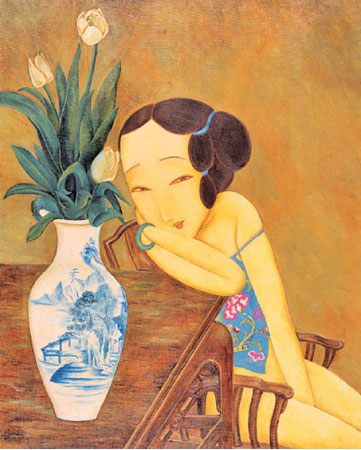Chinese painting
Chinese painting is one of the oldest continuous artistic traditions
in the world.
Painting in the traditional style is known today in Chinese as guóhuà
(Simplified characters, meaning 'national' or 'native painting', as
opposed to Western styles of art which became popular in China in the
20th century.) Traditional painting involves essentially the same
techniques as calligraphy and is done with a brush dipped in black or
coloured ink; oils are not used. As with calligraphy, the most popular
materials on which paintings are made are paper and silk. The finished
work can be mounted on scrolls, such as hanging scrolls or handscrolls.

Traditional painting can also be done on album sheets, walls, lacquer
ware, folding screens and other media.
The two main techniques in Chinese painting are: Gong-bi, meaning
"meticulous", uses highly detailed brush strokes that delimits details
very precisely. It is often highly coloured and usually depicts figural
or narrative subjects. It is often practised by artists working for the
royal court or in independent workshops.
Ink and wash painting, in Chinese Shui-mo also loosely termed
watercolour or brush painting, and also known as "literati painting", as
it was one of the "Four Arts" of the Chinese Scholar-official class.
In theory this was an art practised by gentlemen, a distinction that
begins to be made in writings on art from the Song dynasty, though in
fact the careers of leading exponents could benefit considerably. This
style is also referred to as xie yi or freehand style.
Chinese painting and calligraphy distinguish themselves from other
cultures' arts by emphasis on motion and change with dynamic life. The
practice is traditionally first learned by rote, in which the master
shows the 'right way' to draw items.
Early periods
The apprentice must copy these items strictly and continuously until
the movements become instinctive. In contemporary times, debate emerged
on the limits of this copyist tradition within modern art scenes where
innovation is the rule. Changing lifestyles, tools, and colours are also
influencing new waves of masters.
The earliest paintings were not representational but ornamental; they
consisted of patterns or designs rather than pictures. Early pottery was
painted with spirals, zigzags, dots, or animals. It was only during the
Warring States period (475-221 BC) that artists began to represent the
world around them. In Imperial times (beginning with the Eastern Jin
Dynasty), painting and calligraphy in China were among the most highly
appreciated arts in the court and they were often practised by
amateurs-aristocrats and scholar-officials-who had the leisure time
necessary to perfect the technique and sensibility necessary for great
brushwork. Calligraphy and painting were thought to be the purest forms
of art.
The implements were the brush pen made of animal hair, and black inks
made from pine soot and animal glue. In ancient times, writing, as well
as painting, was done on silk.
However, after the invention of paper in the 1st century AD, silk was
gradually replaced by the new and cheaper material. Original writings by
famous calligraphers have been greatly valued throughout China's history
and are mounted on scrolls and hung on walls in the same way that
paintings are.
Luoshenfu by Gu Kaizhi (344-406 AD). During the Six Dynasties period
(220-589), people began to appreciate painting for its own beauty and to
write about art. From this time we begin to learn about individual
artists, such as Gu Kaizhi.
Even when these artists illustrated Confucian moral themes - such as
the proper behaviour of a wife to her husband or of children to their
parents - they tried to make the figures graceful.
Six principles
The "Six principles of Chinese painting" were established by Xie He,
a writer, art historian and critic in 5th century China. He is most
famous for his "Six points to consider when judging a painting".
-Internet |

